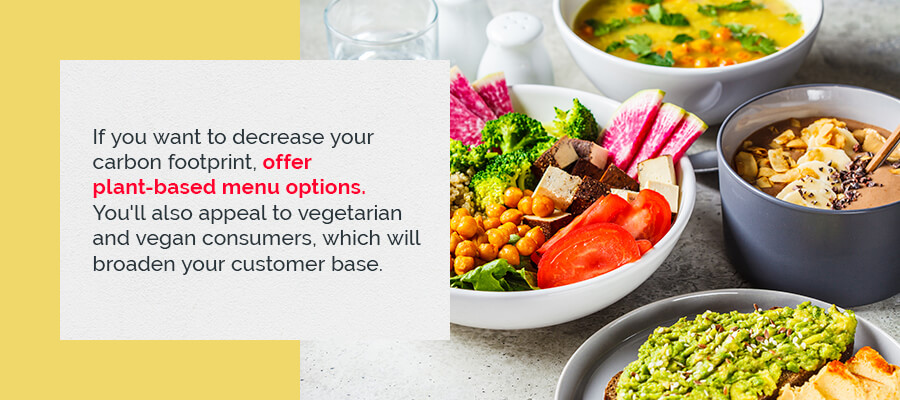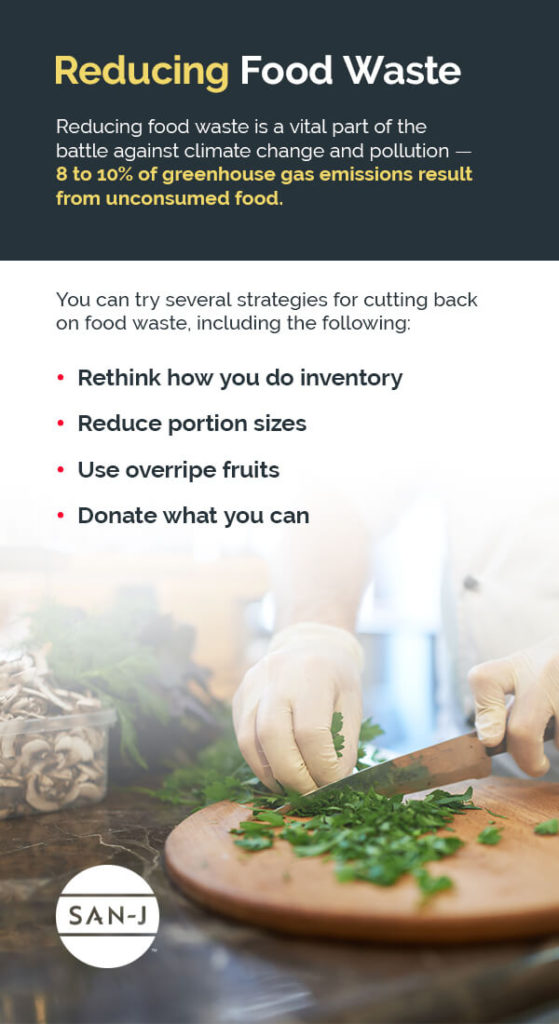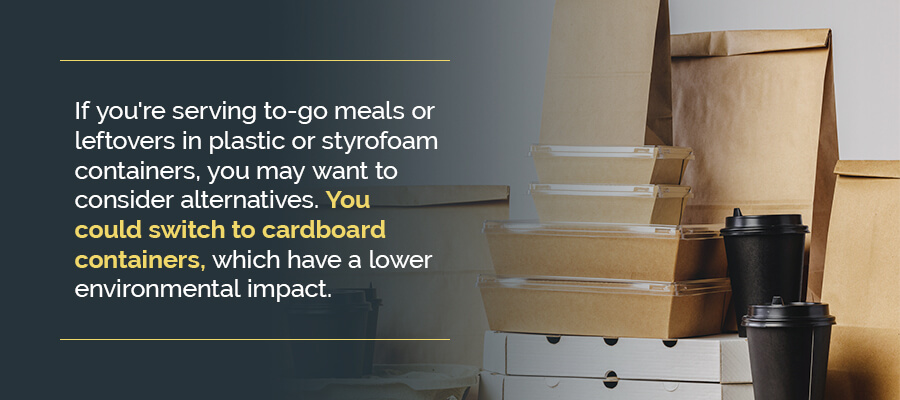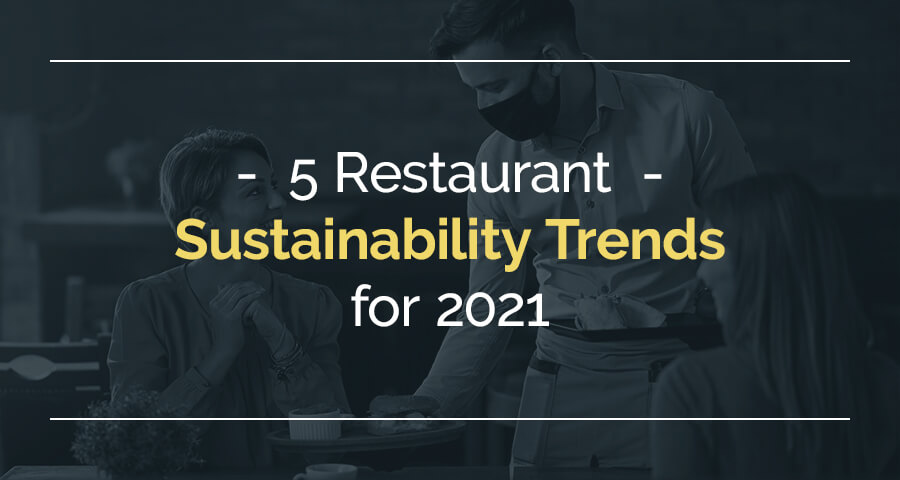Are you looking for ways to make your restaurant more sustainable? Sustainability has become a priority across all sectors, including the restaurant industry. Consumers are knowledgeable about climate change and pollution — they’re ready and willing to do their part.
One way consumers are doing their part is supporting businesses and organizations committed to the environment. Adopting sustainable practices can then have many benefits for your restaurant, including attracting socially conscious consumers. You’ll also earn savings by cutting back on everyday waste. Use simple methods to make your restaurant sustainable in 2021, and learn more about these trends below.
Table of Contents
What Is Restaurant Sustainability?
2021 Restaurant Sustainability Trends
Best Sustainability Ideas for Restaurants
1. Tracking and Reducing Energy Waste
2. Reducing Greenhouse Gas Emissions
3. Reducing Food Waste
4. Replacing or Eliminating Disposable Products
5. Sourcing Organic, Sustainable Ingredients
Use SAN-J Cooking Sauces
Learn More About SAN-J Sauces
What Is Restaurant Sustainability?
Sustainability can mean many different things for various industries. In general, sustainability is all about protecting, preserving or restoring the natural environment. It’s also about promoting social equity and uplifting communities. Restaurants can achieve these goals using a wide range of different methods. Becoming sustainable takes innovation and creativity. Restaurant owners can use the best-suited solutions for their needs and goals.
2021 Restaurant Sustainability Trends
In 2021, you’re likely to see specific trends in restaurant sustainability. Environmental researchers have revealed today’s most critical priorities in mitigating climate change, pollution and other worldwide concerns. Some priorities include reducing single-use plastics, cutting back on both energy and landfill waste and choosing more sustainable ingredients. Socially conscious restaurants will advertise the ways in which they’re contributing to the cause this year.
Best Sustainability Ideas for Restaurants
Consider implementing some ways to create a more sustainable restaurant in 2021. We’ve gathered tips for restaurant sustainability to help you make a real difference in your community, which local consumers will notice. You may want to reduce your energy waste, greenhouse gas emissions and food waste. You could also consider cutting back on disposable products and sourcing sustainable ingredients. In general, we’ve broken down the steps you can take into five categories:
- Tracking and reducing energy waste
- Reducing greenhouse gas emissions
- Reducing food waste
- Replacing or eliminating disposable products
- Sourcing organic, sustainable ingredients
Many of these tips are inexpensive and manageable yet will make a big difference over time. Some may even save you money on upfront or indirect costs. If you want to make a positive impact, try one or more of these 2021 trends for restaurant sustainability.

1. Tracking and Reducing Energy Waste
Energy generation affects the environment. The less energy used, the smaller the environmental impact — efficient energy use can help decrease greenhouse gas emissions and air pollution by reducing the amount of fossil fuels burned. It also saves you money since wasted energy costs can add up.
First, you may want to evaluate how much energy you use and how much goes to waste. You could commission an energy audit, which will help you answer these questions. It’s a good idea to take a careful look at your energy expenses each month, quarter and year. Measuring this way will account for the restaurant industry’s seasonal trends. Tracking your energy consumption will help you see how successful your efforts are moving forward. To reduce energy waste, try some of the following strategies.
Install Timers and Motion Sensors on Your Lights
Lighting rooms with no occupants is a major energy waste. Using timers and motion sensors, you’ll cut back on your light-related energy waste. This automation eliminates the human error of forgetting to turn lights off. Install automatic light technology in the least occupied spaces first, such as the bathroom or any storage rooms.
Use LEDs or Compact Fluorescent Lightbulbs (CFLs)
If you’ve yet to do so, upgrade your light bulbs. LEDs and CFLs use less energy and last longer than traditional bulbs. A CFL uses about one-fourth the energy of a traditional bulb while lasting 10 times longer. LEDs use about the same amount of energy as CFLs but last 15 to 25 times longer than traditional bulbs.
You can find these bulbs in a variety of colors and shapes to match your restaurant’s style. Upgrading your light bulbs is an effective way to reduce your energy waste and save money each month.

Use Natural Light and Fresh Air When Possible
You might also consider making better use of natural light and fresh air to cut back on your energy consumption. Both have significant health effects, which will impact your employees and patrons. Natural light is beneficial in many ways — it offers vitamin D, contributes to healthy eye development, helps you sleep at night and improves your mood. Together, these effects can create a positive and productive environment, all while saving you the expense of artificial light. Consider installing more windows or opening the blinds more often.
You can also make use of natural light by incorporating outdoor seating. If your restaurant has only indoor seating, consider placing some tables and chairs outside where possible and allowed. Patrons love to sit outdoors — fresh air has various health benefits, as well. Though Americans spend about 90% of their time indoors, being outside can make you happier and healthier. It can improve concentration and reduce stress. All these effects can lead to a cheerful dining experience and more satisfied customers.
Invest in Low-Flow Toilets, Sinks and Spray Valves
Low-flow water fixtures are becoming the norm, so it’s a good idea to make the switch sooner than later. In some states, retailers can only sell low-flow models, which may become law elsewhere in the coming years. A low-flow toilet, sink or spray valve can reduce your restaurant’s water waste more than you might think.
According to the Environmental Protection Agency (EPA), older toilets can use as much as 6 gallons of water per flush. Newer, low-flow models use only 1.28 to 1.6 gallons per flush, using a variety of different gravity and pressure techniques. When replacing appliances, look for the EPA “WaterSense” label. This label means the appliance meets the EPA’s water-saving criteria. Using low-flow appliances will help you conserve water, which will also reduce your monthly bills.
Clean Your Commercial Refrigerator’s Condenser Coils
Keeping your refrigerator condenser coils clean can reduce energy waste and extend the appliance’s life span. In any restaurant, an efficient refrigeration unit can have a significant impact on energy usage. Here are the steps you should follow to clean the condenser coils:
- Disconnect the power supply for safety.
- Vacuum away any visible dust and debris.
- Brush away stubborn debris.
- Vacuum again if needed.
2. Reducing Greenhouse Gas Emissions
Another way to make your restaurant sustainable is to reduce your greenhouse gas emissions. Your carbon footprint is both direct and indirect, so think about everything you do when looking for ways to reduce emissions. Here are some potential strategies you can use.
Upgrade Restaurant Appliances
Upgrading appliances helps reduce energy waste and minimize greenhouse gas emissions. If you’re using old appliances, you might want to carve out space in your budget for upgrades. Look for options with Energy Star ratings and EPA approval. You may qualify for tax credits or rebates when you make these changes, so be sure to take advantage of these programs.

Recycle and Reuse
Recycling and reusing objects are effective ways to decrease greenhouse gas emissions and landfill waste. The next time you’re looking to upgrade your furniture or decor, consider sourcing secondhand options or pieces made from recycled materials. These may also be less expensive, helping you minimize costs. You can help support local furniture reclamation businesses, increasing your positive impact on your community, as well.
Be sure to place specified recycling bins in the kitchen and dining areas, too. You might even place bins outside for those passing by to use. Encourage employees and patrons to recycle items whenever possible. As a result, you’ll help keep recyclable materials out of landfills. Though subtle, including recycling bins will help you cultivate a conscientious brand image, as well.
Encourage Carpooling and Public Transport
Odds are, multiple members of your staff arrive for shifts at the same time. If you’re looking for ways to reduce greenhouse gas emissions, encourage employees to share rides or use public transport. You could implement incentive programs, such as offering a bonus or gift to employees who drive carpools. You could even make it a fun, competitive program with rewards and prizes.

Offer Meatless Menu Options or Change Meat Suppliers
An increasing number of environmentally conscious consumers are steering clear of meat and dairy. Meat and dairy production is one of the biggest modern environmental concerns, taking up land, emitting greenhouse gases and polluting ecosystems. Beef production emits more greenhouse gases than any other meat.
If you want to decrease your carbon footprint, offer plant-based menu options. You’ll also appeal to vegetarian and vegan consumers, which will broaden your customer base. You can incorporate protein substitutes such as beans, tofu or artificial meats, as well.
You might also think about sourcing meat from different sources. Look for local small, organic farms offering livestock. Including environmentally conscious, locally sourced meats on your menu can elevate your business. Not to mention, such meat tends to have a richer, better flavor.
Consider Alternative Energy in Your Restaurant
Decreasing reliance on fossil fuels and natural gas benefits the environment. If you have the means, think about investing in alternative energy sources such as solar, wind or hydroelectric. Solar technology has improved over the last few decades and has become more efficient and reliable than ever before. You may actually reduce monthly costs when you increase your energy independence with alternative technology. Again, there may be tax incentives for choosing alternative energy, so be sure to look into all your options.

3. Reducing Food Waste in Restaurants
A major restaurant sustainability concern is food waste. The United Nations Environment Program (UNEP) estimates 17% of all food in homes, restaurants and shops goes to waste. Reducing food waste is a vital part of the battle against climate change and pollution — 8 to 10% of greenhouse gas emissions result from unconsumed food.
Food waste also has significant social implications. Millions of people go hungry each day while households, restaurants and shops throw away excess food. By cutting back on your restaurant’s food waste, you can help alleviate widespread hunger. Food not in your dumpster is food redistributed.
Socially conscious consumers will want to know how you’re doing your part to decrease global food waste. Minimizing food waste is beneficial for the environment. At the same time, it’ll help your restaurant by reducing unnecessary expenses. You can try several strategies for cutting back on food waste, including the following:
- Rethink how you do inventory: If you’re throwing away excessive amounts of food, you may need to rethink how you keep inventory. It could help to order smaller quantities of food at a time. Pay attention to how much you order and how much ends up wasted.
- Reduce portion sizes: In many cases, food waste is a direct result of large portion sizes. If your customers have trouble finishing their plates, consider making your portion sizes smaller.
- Use overripe fruits: Some foods can take on new life when they are no longer servable. Overripe fruits, for example, are great for baked goods and desserts. Do what you can to make use of your food when it’s still safe to eat rather than wasting it.
- Donate what you can: Many areas have local food recycling organizations. Such organizations redistribute food that would be wasted otherwise. You could even set up or sponsor your own local donation events — this also would help you earn a positive community reputation.
4. Replacing or Eliminating Disposable Products
Another way restaurants contribute to pollution is by handing out large quantities of single-use, disposable products. Some of the most detrimental single-use plastics are common in restaurants, including plastic straws, drink stirrers, cutlery, coffee cups, lids and containers. Overall, about 40% of plastics produced are single-use. The World Wildlife Fund recommends consumers choose restaurants that use alternatives to single-use plastics.
Cutting back on single-use plastic is one of the most important things you can do for the environment. You’ll have several choices for achieving this goal. Here are some possible solutions for eliminating or replacing specific types of plastics.

Rethink Plastic Straws
Plastic straws weigh so little and are so small, they blow through the air or flow with streams, often ending up in the ocean. Once in the ocean, they are deadly for wildlife.
In 2021, an increasing number of restaurants may eliminate disposable straws altogether. This change would benefit the environment the most but may not be a viable solution for all restaurants. Thankfully, other solutions are available. You might replace your plastic straws with ones made of other materials. You can find straws made from:
- Stainless steel: Many reusable straws are made from stainless steel. You could serve drinks with these straws and reclaim them with the other dirty dishes at the end of patrons’ meals. Of course, if you’re sending drinks out the door, you’ll want other options.
- Bamboo: A biodegradable alternative, bamboo straws serve the consumer the same way a plastic straw would, without the drastic environmental impact.
- Pasta or rice: Yes, they make straws from pasta and rice! These are also biodegradable alternatives your patrons can use as a disposable straw.
If you lack the means or resources to replace your disposable straws with one of these alternatives, that’s OK. Instead, you could keep plastic straws on hand but stop giving them out unless requested. While this would not eliminate your plastic straw use, it would decrease it significantly Or, if you offer drinks to-go, you might opt for lids with sip openings rather than straw openings.
Swap out Plastic Cutlery
Another major concern is plastic cutlery. If your restaurant is handing out several plastic utensils with every takeaway meal, you’re contributing to non-biodegradable waste. Here are some ways you can cut back on plastic cutlery:
- Switch to bamboo: Like bamboo straws, bamboo cutlery is an excellent alternative. If you can, consider switching to bamboo for your to-go containers.
- Hold unless requested: Again, though this will not eliminate your plastic cutlery use, it will reduce it by a significant amount. If you’re offering to-go boxes, make sure your patrons know they will only have plastic cutlery if they ask for it.
- Sell reusable travel sets: This option may be your best choice for several reasons. For one, you’ll help make reusable travel cutlery sets widespread, contributing to a sustainable community. You’ll also be able to partner with one of the emerging sustainable businesses creating these sets. You might choose to split the profit, earning you some extra funds, or give all proceeds back to your partner, improving your brand image. Either way is a win-win.

Avoid Disposable Plastic Containers
If you’re serving to-go meals or leftovers in plastic or styrofoam containers, you may want to consider alternatives. You could switch to cardboard containers, which have a lower environmental impact. You could also swap to compostable containers, but make sure they contain no toxic chemicals. Another solution is to use durable takeaway containers with re-attachable lids, encouraging your patrons to reuse them or return them back to your restaurant.
5. Sourcing Organic, Sustainable Ingredients
Any restaurant’s most important asset is its ingredients — ingredients are what upgrade food into a dining experience. The way you source your ingredients affects your environmental impact. When you buy artificial, modified ingredients, you may contribute to unsustainable practices. Instead, source organic, sustainable options. This choice can have a positive environmental influence. What’s more, it’ll improve your flavors and produce greater customer satisfaction.
Use SAN-J Sauces for restaurant sustainability
If you’re looking to enhance your meals with sustainable ingredients, consider using SAN-J Asian Cooking Sauces. At SAN-J, our products are made with no artificial preservatives, colors, flavors or additives. Our Organic Tamari and Organic Reduced Sodium Tamari is certified:
- Non-genetically modified (GMO) by the Non-GMO Project
- Organic by the United States Department of Agriculture (USDA)
- Gluten-free by the Gluten-Free Certification Organization (GFCO)
- Vegan by Vegan Action
- Kosher by the Orthodox Union
With SAN-J Tamari, you can cater to many diverse patrons, including those who are vegan or gluten-free. We also offer reduced-sodium versions. We have a wide selection of Asian cooking sauce flavors to match various palates, as well, including:
- Thai Peanut Sauce
- Teriyaki Sauce
- Szechuan Sauce
- Sweet & Tangy
- Orange Sauce
- Mongolian Sauce
- Hoisin Sauce
- Korean BBQ Sauce
Using plant-based, sustainable ingredients will help you have a better environmental impact. Our SAN-J Asian Cooking Sauces will elevate your menu items while contributing to your restaurant sustainability goals.
Learn More About SAN-J Cooking Sauces
Try some of these restaurant sustainability trends in 2021. Many environmentally friendly changes have multifaceted benefits — they’ll contribute to your positive brand image and help you reduce operating costs. They can also make your staff and patrons happier and healthier. Taking advantage of natural light and fresh air can improve mood and concentration, while using organic, plant-based ingredients has positive health implications.
You can make your menu more flavorful and sustainable with SAN-J Asian Cooking Sauces. Learn more about how we brew our sauces — our process results in rich, aromatic flavors your customers will love. Choose the right sauces for your menu and shop our food service options today.
Back to Top

